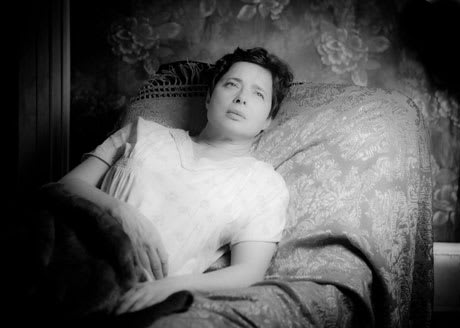Keyhole is the story of a gangster returning home. Since said gangster (Jason Patric) is named Ulysses, of course an odyssey of sorts must take place, so he travels from room to room in search of his wife, Hyacinth (Isabella Rossellini). This being a Guy Maddin film, the retro aesthetic of gangster lore is broken apart and thrown back in pieces at the audience. Once Ulysses' gang has taken cover from gunfire inside his home and Ulysses has returned with a drowned girl slung over his shoulder, the film transforms into not so much a dreamscape as a cinematic fever dream: the drowned girl returns to life and ghosts of dead relatives appear and disappear. The movie never regains the momentum of its first few minutes, but it stays almost as frantic throughout. Keyhole is Maddin's first feature film since his acclaimed My Winnipeg (2007) and his first to be shot entirely in digital format. When the Canadian auteur was promoting Keyhhole, he was asked about filming with Canon 5Ds and said, "I just sort of sucked up imagery with these little Dustbusters for 15 days." The results are scattered. On the surface, Keyhole stands with My Winnipeg and Brand Upon The Brain! (2006), embodying a deep nostalgia that informs the narrative and aesthetic alike. But unlike those two films, the narrator in Keyhole is much more lucid, often speaking cryptically to Ulysses and essentially giving only clues to the audience. Maddin may liken his work to the filmic equivalent of punk rock, but here it plays more like chaotic jazz. Without a reliable narrator to act as a guide, what barely holds Keyhole together — or what contains it — is the house that Ulysses journeys through. The house isn't just haunted, but is an unearthly space where time seems to stop and the dead come alive again. Keyhole might have a spiritual cousin in Michel Gondry's Eternal Sunshine of the Spotless Mind (2004) — at the end of that film, the characters explore a beach house (or rather, the memory of one) as it crumbles and is washed away by the tide. Maddin's film has no use for the straight narrative through line that Gondry's did, interested exclusively in the memories in the recesses of the mind: what they draw us towards and what they make us run away from. It's a somewhat rocky foundation to build either a house or a film upon, but one that can be as haunting as it is frustrating. Bonus features on the Blu-Ray/DVD release include "Send Me to the 'Lectric Chair," described as one of the "workbook sketches" Maddin made for Keyhole, intending originally to construct the feature out of short films. It's not quite the key to the keyhole of the title, but another piece of a puzzle that might have too many.
(eOne)Keyhole [Blu-Ray]
Guy Maddin

BY Cal MacLeanPublished Aug 2, 2012